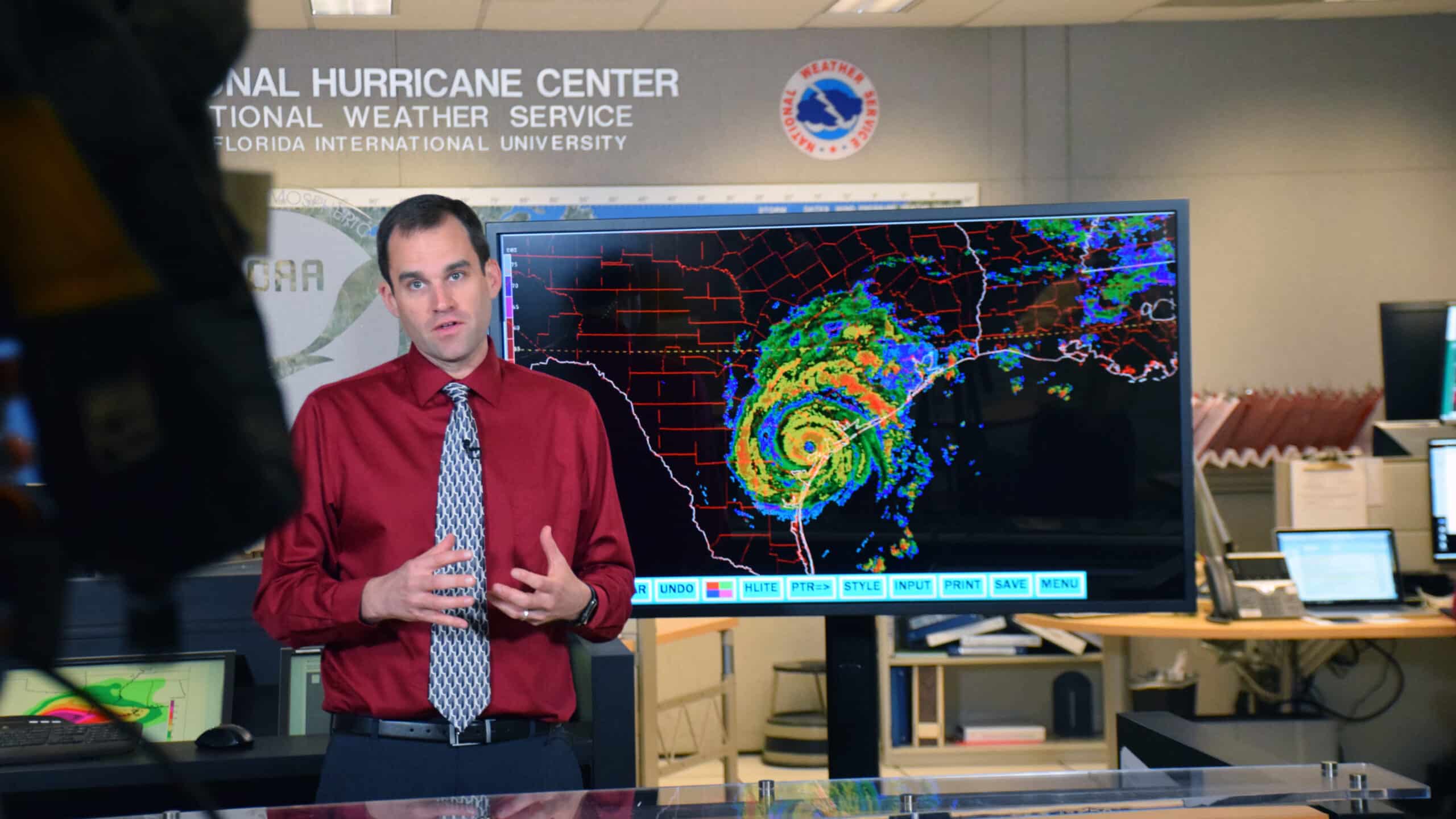Three-Time Grad Named Director of Hurricane Center
Michael Brennan, a three-time graduate of NC State’s College of Sciences with bachelor’s, master’s and Ph.D. degrees in meteorology and atmospheric sciences, has been named the 14th director of NOAA’s National Hurricane Center in Miami.

Mike Brennan first became interested in studying hurricanes when he was 8 years old.
That’s when a catastrophic flood caused by the remnants of Hurricane Juan blew through his hometown of Roanoke, Virginia, causing 62 deaths and some $1.4 billion in damage .
Among the damage was the total destruction of his grandmother’s house in the Roanoke Valley.
“I think most people who are meteorologists all had some kind of experience as a child that led to a fascination with weather,” Brennan said in a 2011 interview. “(Those floods) made an impression on me.”
He spent time in high school working at a Virginia television station and in college as an intern at Raleigh’s WRAL learning broadcast meteorology, but he turned his attention to research and forecasting, first by attending Virginia Western Community College and then enrolling at NC State.
Monday, Brennan was named the 14th director in the history of the National Oceanic and Atmospheric Administration’s National’s Hurricane Center, taking over the permanent position at the division responsible for tracking and predicting tropical weather systems.
Brennan trained for the new position by earning three degrees from NC State — a bachelor’s in meteorology and both a master’s and a Ph.D in atmospheric sciences — and spending nearly 15 years at the NHC’s Miami headquarters as a senior hurricane specialist.
Among his first orders of business: releasing the NHC’s annual forecast for the 2023 hurricane season, which begins June 1. (Spoiler alert—this year’s forecast says the season will be in line with historical averages.)
Brennan is well-known in North Carolina weather circles. His academic work included cold-air damming erosion (his master’s thesis) and the failed forecasts of the 2000 snowstorm that dumped 20 inches of snow on the Triangle.
Throughout his career he has maintained close contact with his instructors, advisors and mentors in the College of Sciences, as well as the state climate office on Centennial Campus, because of North Carolina’s place as the nation’s most meteorologically diverse state that has been affected many times by hurricanes, tornadoes, coastal flooding and other climate-change erosions.
“Our office has worked directly with Mike over the years, and we’re thrilled by this pick,” said Kathie Dello, North Carolina’s state climatologist and director of the climate office. “He’s a savvy scientist, dedicated public servant and will be committed to keeping people and property safe from destructive hurricanes.”
A brief Q&A with Brennan:
Q. You grew up in Roanoke, Virginia, and the flood caused by the remnants of Hurricane Juan destroyed your grandmother’s house. Wondering if that was the start of your interested in studying weather and hurricanes?
Brennan: Yes, that’s right. In November 1985 moisture from the remnants of Juan resulted in a multi-day heavy rainfall event across much of western Virginia, and that event is still the flood of record on the Roanoke River in Roanoke. My grandmother’s home was flooded and my dad had to rescue her in waist deep water. I was 8 at the time, and the event certainly made a big impression on me. Like most meteorologists I had an interest in weather from a very early age, and growing in southwest Virginia we had a variety of weather from snow and ice storms to heavy rainfall, thunderstorms, etc. I do think the 1985 flood made an impression on me of the importance of communication and warning people about hazardous weather that I carry with me even now.
Can you discuss the impact that Prof. Gary Lackmann had on you while at State?
Prof. Lackmann was my advisor in graduate school, and he really instilled the importance of connecting the research we were doing to societal impacts, which is a foundational principle of NC State itself. I had the opportunity to work on research that was very focused on improving weather forecasts in the Carolinas and mid-Atlantic from difficult temperature forecasts in the winter during Cold Air Damming events to trying to improve precipitation forecasts in winter storms, such as the January 2000 snowstorm. Gary also emphasized the importance of being able to effectively communicate your work to a wide variety of audiences, from other scientists to the general public, which is a big part of what I do today.
Another weather event, the snow-icane of 2000, had an impact on your academic career. Can you share a little about what you discovered while researching why predictions of that were so wrong for your Phd.?
My PhD research focused on why real-time model forecasts for the January 2000 snowstorm were so poor, especially in terms of how far inland heavy precipitation occurred even within 24 hours of the event. I found that there was an area of thunderstorm activity that formed over portions of the Gulf Coast states that was critical to the development of the surface low, its eventual track, and the transport of Atlantic moisture into North Carolina, which resulted in the heavy snowfall that occurred. At that time, weather forecast models didn’t handle this type of thunderstorm activity well, which formed above the surface in a very cold air mass, and that was one of the factors in the poor forecasts.
Finally, can you talk about your on-going collaborations with the folks here at the NC Climate Office and in NC State MEAS?
The NC Climate Office has been great about providing observational data over the years that have been helpful in our final analysis of tropical storms and hurricanes that have affected North Carolina. We are always grateful for data on wind, rainfall, pressure and other variables that help us with our post-storm reports.
- Categories:


